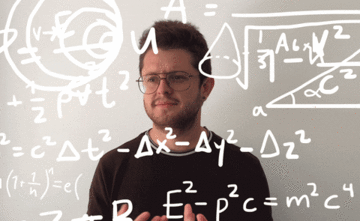Optics related math
Here's a page with maths related to diopters and glasses.
You don't really need to know any of this stuff to improve your eyesight, but it's good to know for deeper understanding ![]()
The thin lens equation
where
- = focal length of lens
- = distance to object
- = distance to image
Infinity
The term object at infinity is often used. When is substituted into the thin lens equation, that term vanishes, so that the focal length is then just the image location. For any sufficiently large object distance, the contribution from the reciprocal becomes negligible.
Virtual image
A converging lens (such as a magnifying glass) behaves like a "typical" lens - the incoming light is brought to a focus on the opposite side of the lens.
A diverging lens behaves differently - the light rays spreading from the source object are refracted outwards so that they are diverging even faster. They are not brought to a focus in any intuitive sense. Instead, the light behaves as if it was coming from a closer object. This is termed a virtual image - it lies between the source object and the lens. The thin lens equation still works as long as you use negative numbers to describe both the (virtual) image location and the focal length.
The corrective lens for myopia is a diverging lens. It works by forming a virtual image of objects far away, and it is that virtual image that the near-sighted eye is able to focus on.
Diopters are inverse meters
Intuitively, the more powerful a lens is, the more rapidly it can bring incoming light to a focus. So the power is defined as the inverse of the focal length.
See Also Diopters
See Also cm Measurement
Remember that 100cm = 1m.
conversely
Calculating correction
How to calculate the strength of corrective lenses
From 20/20 prescription
The advantage of calculating the strength of differentials as a reduction from full prescription is that you don't have to worry about the cylinder element - just preserve that part.
Assuming you are wearing your full 20/20 correction (or even if you are fortunate to be emmetropic), the eye wants to receive parallel incident light to be relaxed. So we can use a simple geometric argument to calculate the strength of the (converging) lens which should be interposed : an object placed at the focus of a converging lens will result in parallel outgoing light ("focus at infinity"). This parallel light is exactly what the (fully corrected) eye wants to receive.
But rather than actually placing such a lens in front of your full prescription, simply subtract that value.
ie if your screen is 50cm away, that corresponds to a power of . So that's the value you'd subtract from your full prescription.
From blur horizon of naked eye
Note that this does not take either cylinder (astigmatism) or vertex distance into account.
Your cm measurement gives you the distance the eye can see when it is fully relaxed. You want a (diverging) corrective lens which puts a virtual image of the source object there. So we can solve the thin lens equation to find for an arbitrary source object distance given .
For full correction, that's easy : and so . Eg if your blur horizon is 20cm you need a 5D correction.
For differentials to use a screen at, say, 50cm, just use . (Which is consistent with the previous version, subtracting 2D from the full correction of 5D.)
Point of refraction
See also Refraction
Visual acuity equation
Note: 5Arcminutes = 20/20
Set up proportion:
Visual acuity (mm/metres)
Visual acuity (in/feet)
With text that we are familiar with, the brain may clear up that text more than our vision would actually allow.[1]
Average axial length accomodation/rate of change
If someone with typical eyes wanted to adapt say 20/20 to .25 less normalized within 3-4 months would need to decrease axial length 0.083mm about 0.92microns/day - 0.69microns/day average Credit: Mark Podowski
Converting from Glasses to Contact Lens Prescription or vice-versa
References
- ↑ The EndMyopia Blog, https://endmyopia.org/use-math-to-turn-any-text-into-your-own-impromptu-eyechart/

















